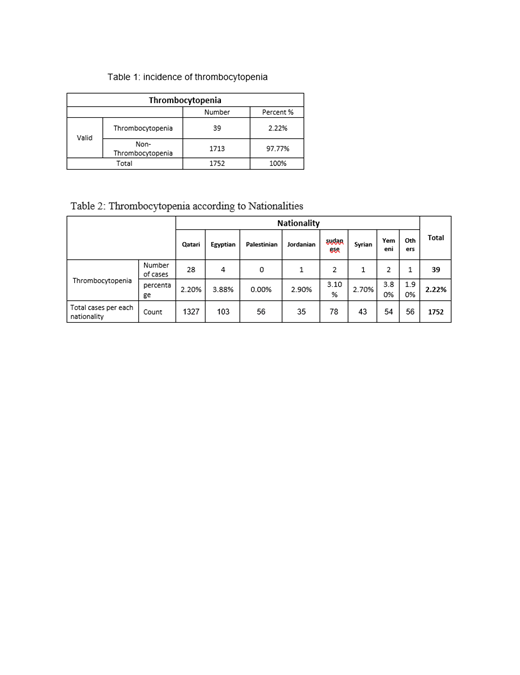Abstract
Prevalence of Thrombocytopenia among Iron Deficiency Anemia in Arab population in Qatar
INTRODUCTION / BACKGROUND
Iron deficiency anemia is a common cause of anemia, and account for almost half of the causes of all anemias. It is well known and common that iron deficiency anemia can be with thrombocytosis, A study reviewed 450 patients with a diagnosis of anemia between 2002 and 2006 was performed in which 143 of them were having IDA found that 31% of them were having associated thrombocytosis (4).
A retrospective study conducted in Turkey found that Iron deficiency anemia and thrombocytopenia found in 13 from 615 patients (2.1%) (5). IDA and thrombocytopenia are found in certain ethnicity where we don t have data from studies about Arab Population.
Materials and Methods
We retrospectively reviewed the electronic medical records of patients attended hematology/ IV iron room clinics with the diagnosis of IDA over 2 years from the period between December 2017 to December 2019 in Hamad Medical Corporation, Qatar. Complete blood count and iron parameters were collected and analyzed. Thrombocytopenia was defined as Platelet count of less than 150 × 109/L. Statistical analysis was done using mean and SD and paired t test to compare variables after versus before treatment.
Depending on previous studies available in the literature, the prevalence of IDA and thrombocytopenia reported from the study done in Turkey (2.1%), based on this we expect the prevalence estimates in Arab population is 3% (with margin of error +/- %) and confidence level 95%, the required sample size needed would be a total of 1744 participants +- 0.8. The adequate sample size was determined using the following statistical equation:
Inclusion Criteria:
Arab Female who is diagnosed with iron deficiency anemia or iron depleted and receive iron therapy.
Exclusion criteria:
Extreme age less than 18 and above 65
Any chronic organ dysfunction or failure
Previous bariatric surgery or gastrostomy
Malignancy (Known or discovered at any time during study follow up)
Results:
Out of 1752 cases of IDA, 39 cases had thrombocytopenia, (2.2 %) (table 1) with mean age of 41.38. The mean Platelet count was 108 x 10^9 in patients with thrombocytopenia while it was 325 x 10^9 in non-thrombocytopenia patients. Platelets count mean increased to 179 x 10^9 after iron replacement (p < 0.05). Analysis of thrombocytopenia according to nationalities was obtained which showed 28 cases among Qatari's (2.2%), 4.1 % in Egyptians, 3.8% in Yemenis, 3.1% Sudanese, 2.9%,2.7% in Jordanian and Syrian respectively and 1.1% in other nationalities (table 2).
Discussion:
Qatar is multinational country with large number of expatriates working in it. In our study thrombocytopenia occurred in 39 cases out of 1752 cases included in the study which represent 2.2% of them. Most of our patients were of Qatari nationality 1327 in which 28 cases of thrombocytopenia were found, with 3.8 % in Egyptian the 2nd most common Arab residents in Qatar. Further analysis according to nationalities revealed 3.1%, 2.9%, 2.7% in Yemenis, Sudanese and Jordanian patients, with 1.1% in other patients from other Arab nationalities.
Comparison of blood parameters including platelet count before and after iv iron therapy were obtained which showed mean platelet count was 108 x 10^9 which increased to 179 x 10^9 after iron therapy, The mechanisms for the thrombocytopenia associated with IDA are not well established, although iron plays a critical role both in the synthesis of platelets and in the regulation of thrombopoiesis.
Other blood parameters including WBC, ANC, Lymphocyte count showed decremental responses after iron therapy with WBC dropped from 6.3 to 6.1, ANC from 3.5 to 2.7 and lymphocyte count from 1.9 to 1.8 in thrombocytopenic patients.
Conclusion:
The prevalence of thrombocytopenia among IDA in Qatar was 2.2%, which normalized after iv iron therapy.
No relevant conflicts of interest to declare.


